This is the fourth set of profiles of people we have met in India. In this post, meet two people for whom education becomes a mixed blessing.
(For the previous profiles, click Profiles 1 or Profiles 2 or Profiles 3)
Uneasy Reader: Mother and son in farming village
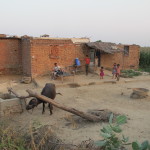
His mother sat with us on the steps of the bare wooden porch. Our local wildlife guide was brewing some tea from the boiling water she had brought us. Her older daughter sat shyly nearby. Younger children played in the dust a few meters away. Farther off, in front of another weathered wooden building, sat her gangly son playing absent-mindedly with some sticks.
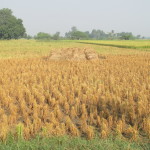
Behind the buildings, their crop-filled land drifted into the distance, with no apparent borders between theirs and other villagers’ fields, if there even were borders. We had already passed many similar homes quite far apart from each other. Every so often a tight collection of structures defined a town, a center for trade and socializing.

We were within Chambal National Park in Madhya Pradesh, right next to Rajasthan, on land preserved for rare sarus cranes, blackbuck and hundreds of other birds and mammals. The space they occupy overlaps and is nearly indistinguishable from the cropland we now sat by.
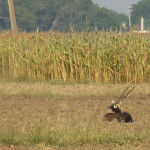
Earlier that day we had slowly traveled the Chambal River, a placid waterway with unusual and endangered reptiles such as the alligator-like gharial and the colorful red-crowned roof turtle, along with majestic water birds. Other local villagers poled their boats and cast nets to harvest fish just as their unremembered ancestors had.

Villagers and wildlife often find common ground in India, as well as other Asian countries. Even in lands where Bengal tigers roam, spaces now also reserved and protected by the Indian government, villages sit on the periphery or plunk in the middle of those conservation properties.

Mostly this arrangement is advantageous for both human and animal residents. The animals gain protection and space; the humans preserve their livelihood, funding for schools and technology, tourist cash, as well as jobs on the park staff. Even in the Sunderbans delta, the only place known for tigers that attack people, villagers continue to fish the brackish waters and live near where the tigers roam – though with the modest protection of mesh fences. Near the Kabini River, driving the backcountry suddenly reveals neatly arrayed village homes or passes villagers walking to or from their farmwork. They become accustomed as well to passing tigers, but they meatier prey on their minds.

Occasionally these worlds conflict, if tigers or other wildlife become too much of a pest – attacking goats, say, or destroying crops. But, in general, the government, wildlife and villagers seem to have worked out a reasonable way to balance each of their interests.
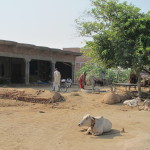
Despite the need to adapt to formal sharing of their land, as well as the influx of tourists and advent of technology, the villagers appear to hold onto the culture they know. The custom we were enjoying on the villagers’ steps was the traditional way of welcoming guests – whether friends or strangers. Show up on the doorstep and the family will greet you, sit a while in conversation, prepare you some tea and offer to share some food. The day before, we thought we had stopped at some unmarked inn because the home owner set out chairs, brought water and bread for us, then offered us the use of their basic toilet facility. It was just the same custom and the same hospitality as we were currently enjoying near the Chambal River.
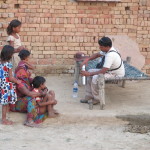
So what about that gangly boy, a mature looking 11 year old?

While we drank our tea, a bit of laughter interrupted the conversation in Hindi between our guide and his mother. “What did she say?” we asked. “He doesn’t like to read,” our guide translated, as she beckoned at her indolent son, nor keep up with his schooling. She didn’t seem to like his resistance, but the laughter suggested she was not too disturbed.
Soon he would be working full-time alongside the men in the field, or perhaps helping to preserve the wildlife. It seemed that the demands of the land, along with the customary communal support the villagers rely on, made school a bit less important. Reading words on a page doesn’t seem to matter so much.
Great Expectations: A Spice Farmer
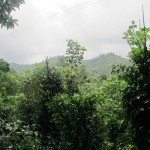
Education is a dangerous thing, the spice farmer told us, while we sat on the porch of his home overlooking hillsides laden with his spice trees and plants. That’s why, he explained, it was becoming so much harder to find workers who wanted to sweat and strain in those fields, especially workers from this Periyar region in Kerala. Now he had to import presumably less educated workers from the poorer neighboring states of Tamil Nadu and Andra Pradesh. But all they want to do with their money, he lamented, is get so drunk that, for the next few days after their binger, they are unable to work at all.
He himself became a farmer about 40 years ago after completing just the 8th grade. Yet, now he owned several hectares of fertile land perfect for growing a variety of spices, especially cardamom, the ubiquitous flavor in Indian food.

The quality of workers wasn’t his only problem. His customer’s palates were also deteriorating, unable to appreciate his high quality cardamom. Large producers in Brazil were undercutting prices with lesser grade product. They were machine-harvesting the spice, shipping it in powder form to India. Then local distributors mixed the Brazilian stuff in with a bit of local product for unwary buyers. “Don’t they notice it has no taste?” he lamented shaking his head.
His own highly educated family also wanted something different from the farming life. His daughter – with a masters in electrical engineering – lived and worked in the large, traffic-choked city of Chennai, Tamil Nadu. His son had studied in the UK and stayed there to live. A decade ago, our host had built his son the beautiful house we were staying in; his son never used it.
With his son gone, he first considered turning the house into a tourist homestay, but he worried whether his low education would make it difficult for him to relate to foreigners. That admission surprised us: we saw him as a successful businessman and an attentive host. He realized he didn’t need to worry about his 8th grade education after his first visitor, a German. He had taken him around the area, making a special stop at the most scenic vista about. The man hugged him in appreciation – and returned many times since.
Through his family and in his workforce, our spice farmer exemplified a generational shift of expectations due largely to the disruptive nature of education. Everyone wants more, he noted, including the larger opportunities and bigger pay scales they see in the west. “How do you get a working visa in America?” he asked us, with his thoughts on his daughter’s potential.
(Also, for more pictures from India, CLICK HERE to view the slideshow at the end of the India itinerary page.)





